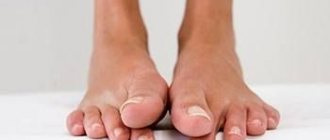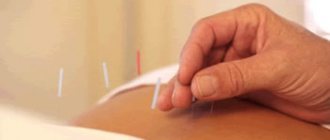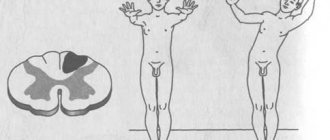Sometimes, due to a variety of reasons, numbness in certain parts of the body may occur.
If this happened once, for example, as a result of an uncomfortable position in a dream, then there is nothing wrong with it.
But if loss of sensitivity occurs quite often and lasts a long time, then this is an alarming symptom that requires immediate medical intervention.
Hypesthesia is a dulling of sensations , a weakening of sensitivity in certain parts of the body, as a result of which a person loses the ability to adequately perceive the action of external stimuli, as well as respond to changes occurring in his body.
This is due to a disruption in the functioning of human nerve endings. Often the disease can appear during pregnancy, and after childbirth it disappears on its own.
The disease manifests itself as follows:
- a person does not feel anything when he touches objects;
- he feels the pain dulled, even if it is quite strong;
- cannot determine temperature differences;
- If the vagus nerve is damaged, hearing may be impaired.
Often the disease makes itself felt when metabolic processes are disrupted, resulting in fluid accumulation in the fingers and hands.
Hepatic encephalopathy - causes and symptoms, treatment methods, prognosis and prevention of the disease.
How does brain astrocytoma, whose life prognosis is extremely unfavorable, stand out from other brain tumors? Is there a chance of salvation?
Causes of hypoesthesia
Hypoesthesia usually occurs due to pathological changes in the central and peripheral nervous system, provoked by such factors:
- Brain injury.
- A malignant formation, which, by limiting the volume of the skull, leads to numbness of the head. Moreover, as the tumor grows, the damage intensifies, vision is impaired, and headaches occur.
- Migraine.
- Circulatory disorders.
- Pinched nerve.
- Multiple sclerosis, as a result of which certain areas of nervous tissue are replaced by connective tissue cells. In this case, coordination of movements may be impaired.
- Diabetes mellitus, which contributes to nerve damage.
- Transient ischemic attacks, accompanied by damage to the arms and legs.
- Alcohol abuse.
- Deficiency of vitamins and microelements in the body, for example, lack of vitamin B. Associated symptoms may include excessive irritability, dizziness, fatigue and problems with the gastrointestinal tract.
- Rheumatoid arthritis, which affects the nerve and leads to joint deformation. Usually in the morning there is pain and stiffness at the site of the lesion.
- Genetic predisposition.
What causes hypoesthesia?
Now let’s look at what causes most often cause hypoesthesia in adults. This condition is a symptom of many diseases. Some of them can affect the central nervous system and cerebral structures of the brain. Thus, in some cases, hypoesthesia is the initial sign of a brain tumor or developing ischemic stroke. If you pay attention to this condition in time, you can avoid disability and fully restore your health.
Among the potential causes of hypoesthesia of the limbs are the following conditions:
- spasm and incomplete patency of the blood vessels of the brain (often develops as a complication of cervical osteochondrosis associated with posterior vertebral artery syndrome);
- damage to the radicular nerves due to osteochondrosis, protrusion and herniated intervertebral discs;
- tumors of the spinal cord, hard and soft tissues of the spinal column;
- Bechterew's disease (ankylosing spondylitis), systemic lupus erythematosus, scleroderma and other rheumatic processes;
- instability of the position of the vertebral bodies and their periodic displacement relative to each other with compression of the radicular nerves and their branches;
- diabetic angiopathy and neuropathy of the upper and lower extremities;
- spinal canal stenosis;
- spinal trauma (compression fracture, cracks, dislocation and subluxation of the vertebra, hematoma in the dural sac);
- serious infections affecting the spinal cord and brain (tick-borne encephalitis, tuberculosis, meningitis, polio);
- deficiency of certain vitamins (mainly group B) and minerals, which are conductors of nerve impulses, in the diet;
- toxic effects on the human body (taking certain medications, smoking, drinking alcoholic beverages, working in an environmentally unfavorable environment, etc.);
- iron deficiency with the development of anemia and the inability to transport sufficient oxygen to the distal limbs;
- cardiac vascular failure;
- vasculitis and other types of severe damage to the bloodstream (arteries and arterioles).
Identifying the real cause of hypoesthesia is the initial stage of treatment. If an accurate diagnosis is not established, then treating this condition as an independent disease will be useless. Sensory impairment will occur again and again until the cause of the pathology is eliminated.
Classification
Depending on which group of analyzers is affected, the following types of hypoesthesia are distinguished:
- Facial hypoesthesia – occurs due to vascular or neurological pathologies. If sensation is lost in one half of the face, we can talk about trigeminal neuralgia, and in the case of redness or rash in the affected area, the development of herpes zoster may be involved.
- Hypoesthesia of the hands - with loss of sensitivity for two or more minutes, we can talk about the presence of diseases of the nervous or vascular system. This condition can also be caused by multiple sclerosis, a tumor, or a cerebrovascular accident.
- Hypoesthesia of the lower extremities - occurs when blood circulation in the lower extremities is impaired and nerves are damaged. In the presence of severe pain, vascular disease can also be diagnosed - obliterating endarteritis, venous insufficiency, atherosclerosis. If you experience shooting pain in the leg or lower back, this may indicate sciatica.
Hypoesthesia of the leg (hips, legs, feet)
In most cases, hypoesthesia of the leg occurs against the background of the development of lumbosacral osteochondrosis and its complications. Bilateral hip hypoesthesia is the first clinical sign of cauda equina compression. This may be a symptom of a coccyx injury or arthrosis of the sacrococcygeal joint. Unilateral damage is typical for compression of the radicular nerve in the L5-S1 space. With tunnel syndromes, hypoesthesia of the feet, sagging of the arches and the development of transverse, longitudinal or mixed flat feet may appear.
When hypoesthesia of the lower leg appears, it is important to exclude vascular pathologies, such as:
- varicose veins of the lower extremities with severe swelling of the lower third of the leg;
- atherosclerosis (the formation of cholesterol plaques primarily occurs in the large blood vessels of the lower limb);
- obliterating endarteritis (more often formed in men aged 30 to 45 years who smoke);
- diabetic angiopathy.
When the first signs of hypoesthesia of the lower extremities appear, you should consult a neurologist. This doctor will be able to determine the exact cause of the sensitivity disorder during the initial examination.
Symptoms and signs of the disease
Hypoesthesia can be recognized by the following signs:
- high frequency of disease attacks;
- insensitivity to temperature changes;
- numbness in the head, neck, back, as well as paralysis;
- weakness and speech disorders;
- loss of smell;
- short-term loss of consciousness, difficulty breathing;
- dizziness and gait disturbance;
- burning, itching, tingling sensation and rash;
- numbness of the limbs while walking;
- pain in the lumbar region, muscle spasms;
- with facial hypoesthesia, vision and hearing may deteriorate, and the temperature may rise;
- Involuntary bowel movements or emptying of the bladder may occur.
Hypesthesia of the hands (fingers and hands)
Hand hypoesthesia is a common symptom of the development of tunnel syndromes. If the carpal valve or carpal tunnel is damaged, hypoesthesia of the fingers occurs, and if the ulnar nerve is damaged, the entire hand on the affected side may become numb.
In addition to tunnel syndromes, hand hypoesthesia accompanies brachial plexitis or plexopathy. When any of the three branches extending from the brachial nerve plexus is compressed, sensory disturbances in the hand and forearm may occur. Then the loss of sensitivity spreads to the shoulder.
With hypoesthesia of the hands, it is important to begin differential diagnosis with a comprehensive examination of the condition of the cervical spine. There may be two pathological factors that have a negative impact on the process of innervation of the upper extremities:
- with osteochondrosis complicated by protrusion and disc herniation, pressure is exerted on the radicular nerve responsible for the innervation of the arm;
- With posterior vertebral artery syndrome, the blood supply to the brain structures responsible for conducting sensory impulses from the upper extremities is disrupted.
Therefore, it is necessary to conduct a comprehensive diagnosis. Depending on the identified pathology, an individual course of therapy is prescribed.
Diagnostic techniques
If hypoesthesia occurs frequently and lasts more than 2–3 minutes, you should immediately contact a neurologist for examination. It includes the following procedures:
- initial examination, identification of complaints, symptoms, clarification of the patient’s lifestyle and adherence to his bad habits;
- a general blood test to detect iron deficiency or pernicious anemia;
- a blood test for cholesterol and lipoprotein, which makes it possible to identify a tendency to form atherosclerotic plaques;
- computed tomography (CT) and x-ray - these studies will help determine the presence of bone fractures that have caused damage to nerve fibers, and will also help diagnose osteochondrosis, arthritis and other pathologies;
- electroneuromyography, which will make it possible to find the place where the nerve is damaged;
- Doppler ultrasound examination, which makes it possible to detect vascular pathologies such as varicose veins, atherosclerosis, thrombosis and others.
Treatment of the disease
Having determined the symptoms of hypoesthesia, as well as its localization, it is necessary to urgently begin treatment without delay.
The selection of medications is carried out depending on what exactly caused the disease.
For example, if there is hand hypoesthesia associated with metabolic disorders, the doctor may prescribe a course of vitamin and mineral complexes.
Also, to treat numbness, a course of corticosteroids is sometimes used to relieve the exacerbation of the disease.
If the sensitivity of the legs is impaired, a warm shower and evening walks are usually used.
Additional treatment methods include :
- phonophoresis;
- electrophoresis;
- ultrasonic waves;
- darsonval;
- paraffin and ozokerite wraps;
- radon baths and mud;
- massage;
- yoga classes;
- acupuncture.
There is also the opportunity to use traditional medicine. You just have to keep in mind that self-medication is fraught with consequences, so you should always consult with your doctor.
Here are a few popular recipes for hypoesthesia :
- If your fingers are affected, you can take half a glass of sugar and vegetable fat and mix. Apply in circular motions to affected areas. After this, add 2 tablespoons of salt to a liter of warm water and dip your fingers in it for 45 minutes.
- If your legs are numb, honey wraps will be helpful. Sore legs should be lubricated with honey and wrapped in natural fabric. The course of treatment is 3–4 procedures.
- You can also take half a liter of vodka and 50 g of bush lilac flowers, leave for a couple of weeks, and then apply compresses to numb legs. Repeat for two weeks.
Before the treatment has its effect on the patient, he should exercise maximum caution so as not to accidentally harm himself.
So, if attacks are provoked by external factors, such as ambient temperature, time of day or physical condition, then they should be avoided if possible.
If you often experience numbness in your face, you need to be careful when eating, as you may accidentally bite your tongue or cheek.
If you have hypoesthesia, which manifests itself in the form of insensitivity to temperatures, you need to be extremely careful near heat sources, since during an attack you can involuntarily get burned.
Types and types of hypoesthesia
The division into types of hypoesthesia is based on several factors:
- localization (lower or upper limbs);
- symmetry of the lesion (unilateral or bilateral);
- cause (compression, trauma, ischemia, tumor, infection, endocrinology, etc.);
- damage to the type of nerve fiber;
- duration of the course (acute or chronic).
In most cases, there are mixed types of hypoesthesia, which develop against the background of the negative impact of various factors. For example, with a back injury, acute compression hypoesthesia may simultaneously develop with a gradually transforming state into a chronic sensitivity disorder. Next, we will consider in more detail the most common type of pathology.
Conductive hypoesthesia of the distal limbs according to the radicular type
Most patients develop hypoesthesia of the radicular type, which is associated with impaired conduction of nerve impulses against the background of compression at the level of the foramen in the vertebral body. This condition accompanies advanced cases of osteochondrosis. With it, dystrophic degenerative destruction of the fibrous ring of the intervertebral disc occurs. First, it becomes dehydrated and loses its elasticity, then it loses its physiological height. In this condition, the intervertebral disc loses its ability to provide protection to the radicular nerve emerging next to it.
Conductive hypoesthesia can affect not only the arms or legs. It is often localized in the lumbar region, face, groin, perineum, and anterior abdominal wall. Depending on which radicular nerve is affected, distal hypoesthesia may be accompanied by impaired motor function. In this case, in addition to hypoesthesia of the distal limbs, there is muscle weakness associated with impaired innervation and trophism of the underlying muscles.
Disease prevention
In order to prevent further development of the disease, it is necessary to start leading a healthy lifestyle:
- rejection of bad habits;
- healthy, full sleep;
- a balanced diet including vegetables and fruits;
- light exercises to ensure limb mobility;
- walks in the open air;
- alternation of work and rest;
- timely treatment of chronic diseases that can cause hypoesthesia.
So, we found out that hypoesthesia is a rather serious disorder of the body , which cannot be left to chance, expecting that it will go away on its own.
Because sometimes this disease can lead to the most tragic consequences.
Therefore, if you often feel signs of numbness in any part of the body, you should consult with an experienced doctor, and, if possible, get rid of bad habits that contribute to the development of hypoesthesia.










